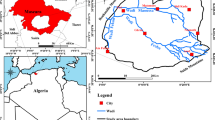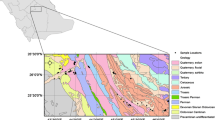Abstract
Enyigba-Ameri area is known for its Pb–Zn mining activities and the mine water is usually discharged directly into nearby streams and surface runoff. In order to determine the impacts of mining activities on the quality of water in the area and the general hydrochemical characteristics, field measurements and laboratory tests were carried out on water samples collected from the area. Field measurements and laboratory analyses of physicochemical parameters were determined using standard methods. In addition to the multivariate analyses (principal component analysis and cluster analysis) and ANOVA analysis, ionic cross-plots were used to determine the groundwater physicochemical characteristics and geochemical evolution. From the results, it was observed that Pb4+, Zn2+, Fe2 + & 3+, Ca2+, Mg2+, and K+ had a concentration higher than the stipulated guideline values. Three principal components which explained 87.42% of the total dataset were extracted through the data reduction process. Cluster analysis of the hydrochemical data grouped the water samples into three distinct classes. It was observed that the water chemistry is mainly affected by silicate minerals weathering, carbonate weathering, and base ion exchange processes in descending order. ANOVA analysis showed that Zn2+, Fe2 + & 3+, and Mg2+ had mean values that significantly differed from each other based on the sources of the samples. The Wilcox diagram revealed 4 classes of irrigation water types and the irrigation water quality indices showed that the groundwater in the area is not generally suitable for irrigation purposes.









Similar content being viewed by others
References
Aghazadeh, N., & Mogaddam, A. A. (2010). Assessment of groundwater quality and its suitabilityfor drinking and agricultural uses in the Oshnavieh area, northwest of Iran. Journal of Environmental Protection, 1, 30–40.
Appelo, C., & Postma, D. (2005). Geochemistry, groundwater and pollution (2nd ed.). Rotterdam: Balkema. https://doi.org/10.1201/9781439833544.
Ayuba, R., Omonona, O. V., & Onwuka, O. S. (2013). Assessment of groundwater quality of Lokoja Basement area. Journal of Geological Society ofIndia, 82, 413–420.
Bodrud-Doza, M., Towfigual Islam, A. R. M., Fahad, A., Das, S., Narottam, S., & Safiur Raham, M. (2016). Characterization of groundwater quality using water evaluation indices, multivariate statistics and geostatistics in Central Bangladesh. Water Science, 30, 19–40.
Datta, D., & Subramanian, V. (1998). Distribution and fractionation of heavy metals in the surface sediments of the Ganges- Brahmaputra-Meghna river system in the Bengal basin. Environmental Geology, 36, 93–101. https://doi.org/10.1007/s002540050324.
Eaton, E. M. (1950). Significance of carbonate in irrigation water. Soil Science, 69, 123–133. https://doi.org/10.1097/00010694-195002000-00004.
Gibbs, R. J. (1970). Mechanisms controlling world water chemistry. Science, 17, 1088–1090
Güler, C., Thyne, G. D., McCray, J. E., & Turner, A. K. (2002). Evaluation of graphical and multivariate statistical methods for classifi- cation of water chemistry data. Hydrogeology Journal, 10, 455–474.
Harman, H. H. (1960). Modern factor analysis. University of Chicago Press, Chicago. Hydrochemistry, dynamics, and contamination processes. Water Resources Research, 38, 9-1–9-17.
Inyang, P. B. E. (1975). Climate. In O. Gek (Ed.), Nigeria in maps, Eastern State (pp. 25–26). Benin City: Ethiope Pub. House.
Jones, B. F., Vengosh, A., Rosenthal, E., & Yechieli, Y. (1999). Geochemical investigation of groundwater quality. In Seawater intrusion in coastal aquifers––concepts* methods and practices (pp. 1–71). Netherlands: Kluwer.
Kaiser, H. F. (1958). The varimax criterion for analytic rotation in factor analysis. Psychometrika, 23, 187–200.
Koffi, K. V., Obuobie, E., Banning, A., & Wohnlich, S. (2017). Hydrochemical characteristics of groundwater and surface water for domestic and irrigation purposes in Vea catchment, northern Ghana. Environmental Earth Sciences, 76. https://doi.org/10.1007/s12665-017-6490-3.
Machiwala, D., & Jhab, M. K. (2015). Identifying sources of groundwater contamination in a hard rock aquifer system using multivariate statistical analyses and GIS-based geostatistical modeling techniques. Journal of Hydrology: Regional Studies, 4(2015), 80–110.
Martin, T. D. (2003). METHOD 200.5 - determination of trace elements in drinking water by axially viewed inductively coupled plasma-atomic emission spectrometry. U.S. Environmental Protection Agency, Washington, DC, EPA/600/R-06/115.
Mohapatra, P. K., Vijay, R., Pujari, P. R., Sundaray, S. K., & Mohanty, B. P. (2011). Determination of processes affecting groundwater quality in the coastal aquifer beneath Puri city, India: a multivariate statistical approach. Water Science and Technology, 64(4), 809–817.
Obiora, S. C., Chukwu, A., Toteu, S. F., & Davies, T. C. (2016). Assessment of heavy metal contamination in soils around lead (Pb)-zinc (Zn) mining areas in Enyigba, southeastern Nigeria. Journal of the Geological Society of India, 87, 453–462.
Okogbue, C. O., & Ukpai, N. S. (2013a). Geochemical evaluation of groundwater quality in Abakaliki area, Southeast Nigeria. Jordan Journal of Earth and Environmental Sciences, 5(1), 1–8.
Okogbue, C. O., & Ukpai, S. N. (2013b). Evaluation of trace element contents in groundwater in Abakaliki metropolis and around the abandoned mine sites in the southern part, southeastern Nigeria. Environmental Earth Sciences, 70, 3351–3362. https://doi.org/10.1007/s12665-013-2401-4.
Okogbue, C. O., Omonona, O. V., & Aghamelu, O. P. (2012). Qualitative assessment of groundwater from Egbe–Mopa basement complex area, northcentral Nigeria. Environmental Earth Sciences, 67, 1069–1083.
Omonona, O. V., & Okogbue, C. O. (2017). Geochemistry of rare earth elements in groundwater from different aquifers in the Gboko area, central Benue Trough, Nigeria. Environmental Earth Sciences. https://doi.org/10.1007/s12665-016-6329-3.
Omonona, O. V., Onwuka, O. S., & Okogbue, C. O. (2014). Characterization of groundwater quality in three settlement areas of Enugu metropolis, southeastern Nigeria, using multivariate analysis. Environmental Monitoring and Assessment, 186, 651–664.
Onwuka, O. S., Omonona, O. V., & Anika, O. C. (2013). Hydrochemical characteristics and quality assessment of regolith aquifers in Enugu metropolis, southeastern Nigeria. Environmental Earth Sciences, 70, 1135–1141.
Piper, A. M. (1994). A graphical procedure in the geochemical interpretations of water analyses. American Geophys Union, 25, 914–923.
Ravikumar, P., Somashekar, R. K., & Prakash, K. L. (2015). A comparative study on usage of Durov and Piper diagrams to interpret hydrochemical processes in groundwater from SRLIS river basin, Karnataka, India. Earth Science, 80, 31073–31077.
Senthilkumar, G., Ramanathan, A. L., Nainwal, H. C., & Chidambaram, S. (2008). Evaluation of the hydrogeochemstry of groundwater using factor analysis in the Cuddalore coastal region, Tamil Nadu, India. Indian Journal of Marine Science, 37(2), 181–185.
Sharma, B., & Tyagi, S. (2013). Simplification of metal ion analysis in fresh water samples by atomic absorption spectroscopy for laboratory students. Journal of Laboratory Chemical Education, 1(3), 54–58.
Singh, A. K., & Hassin, S. I. (2002). Aspects of weathering and solute acquisition processes controlling chemistry of sub-Alpine proglacial streams ofGarhwal Himalaya, India. Hydrological Processes, 16, 835–849.
Singh, K. P., Malik, A., Mohan, D., & Sinha, S. (2004). Multivariate statistical techniques for the evaluation of spatial and temporal variations in water quality of Gomti River (India) – A case study. Water Research, 38, 3980–3992.
Singh, S. K., Singh, C. K., Kumar, K. S., Gupta, R., & Mukherjee, S. (2009). Spatial-temporal monitoring of groundwater using multivariate statistical techniques in Bareilly District of Uttar Pradesh, India. Journal of Hydrology and Hydromechanics, 57(1), 45–54.
SON (2007). Nigerian industrial standard: Nigeria standard for drinking water quality. Standard Organization of Nigeria, 1687 Lome street Wuse, Abuja ICS 13.060.20.
Srinivasamoorthy, K., Gopinath, M., Chidambaram, S., Vasanthavigar, M., & Sarma, V. S. (2014). Hydrochemical characterization and quality appraisal of groundwater from Pungar sub basin, Tamilnadu, India. Journal of King Saud University – Science, 26, 37–52.
Subramani, T., Rajmohan, N., & Elango, L. (2009). Groundwater geochemistry and identificationof hydrogeochemical processes in a hardrock region, southern India. Environmental Monitoring Assessment, 162, 123–137. https://doi.org/10.1007/s10661-009-0781-4.
Tiwari, A. K., Singh, A. K., & Mahato, M. K. (2017). Assessment of groundwater quality of Pratapgarh district in India for suitability of drinking purpose using water quality index (WQI) and GIS technique. Sustainable Water Resource Management, 4, 601–616. https://doi.org/10.1007/s40899-017-0144-1.
Towfiqul Islam, A. R. M., Shen, S., Haque, M. A., Bodrud-Doza, M., Maw, K. W., & Habib, M. A. (2017). Assessing groundwater quality and its sustainability in Joypurhat District of Bangladesh using GIS and multivariate statistical approaches. Environmental Development and Sustainability, 20, 1935–1959. https://doi.org/10.1007/s10668-017-9971-3.
Vengosh, A., Gill, J., Davisson, M. L., & Hudson, G. B. (2002). Amultiisotope (B, Sr, O, H, and C) and age dating study of groundwater from Salinas Valley, California: hydrochemistry, dynamics, and contamination process. Water Resources Research 38(1), 1–17.
Ward, J. H. (1963). Hierarchical grouping to optimize an objective function. Journal of the American Statistical Association, 58(301), 236–244.
WHO. (2011). Guidelines for drinking water quality. Recommendations. Geneva: World Health Organization.
Wilcox, L. V. (1955). Classification and use of irrigation water. Washington, DC; USDA circular 969. 19 p.
Author information
Authors and Affiliations
Corresponding author
Additional information
Publisher’s note
Springer Nature remains neutral with regard to jurisdictional claims in published maps and institutional affiliations.
Rights and permissions
About this article
Cite this article
Omonona, O.V., Amah, J.O., Olorunju, S.B. et al. Hydrochemical characteristics and quality assessment of groundwater from fractured Albian carbonaceous shale aquifers around Enyigba-Ameri, southeastern Nigeria. Environ Monit Assess 191, 125 (2019). https://doi.org/10.1007/s10661-019-7236-3
Received:
Accepted:
Published:
DOI: https://doi.org/10.1007/s10661-019-7236-3




